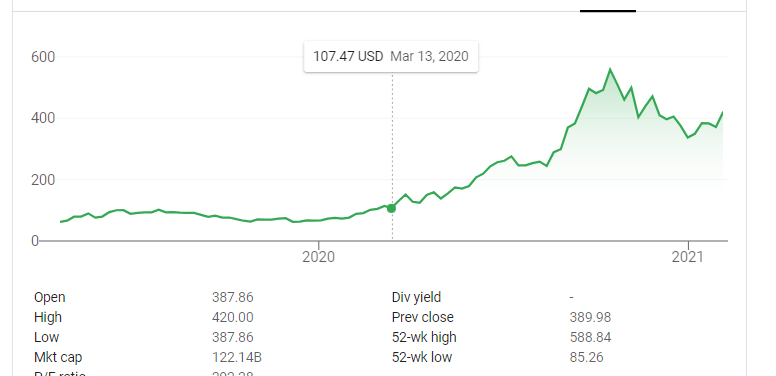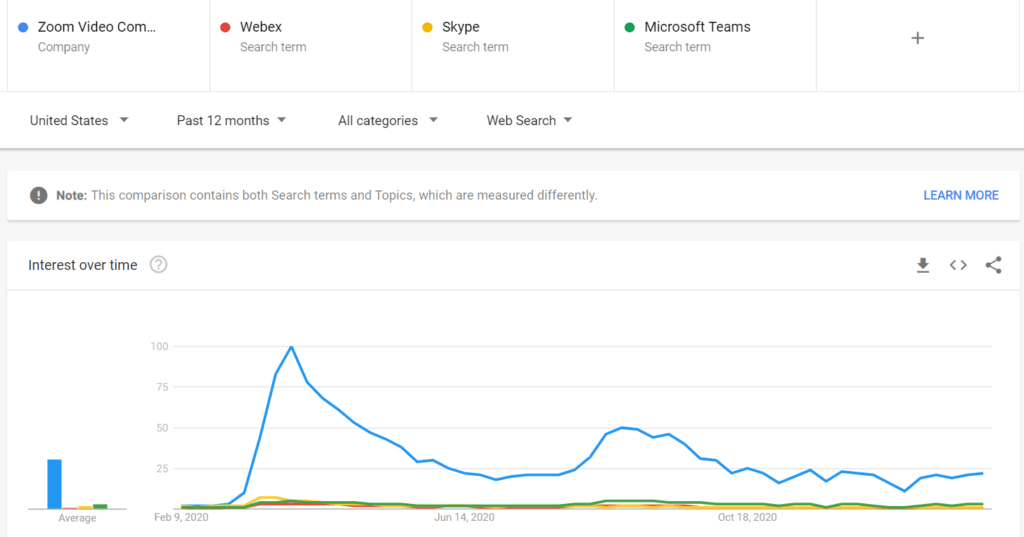How Zoom Won the Pandemic
Zoom is an unambiguous winner in the COVID-19 era. This blog post dives into why Zoom succeeded while its competitors stumbled, how zoom creates and captures value, and what the future may hold for this software company.
When was the last time you ZOOMed into a meeting and thought, god I miss people? Zoom Video Conferencing, or just “Zoom” for short, is one of the most unambiguous winners of this pandemic. We’ve all used it, and the company’s share price reflects this, with more than a 500% increase at its peak, from the mid-march pre pandemic numbers. Figure 1 below shows Zoom’s stratospheric rise over the past year.
Figure 1- Zoom share price history.
Although digital teleconferencing is self-evidently a powerful safety and productivity tool during a pandemic where human contact can lead to infection or death, what is less clear is why zoom specifically succeeded so emphatically. For example, Skype, a competing video conferencing platform owned by Microsoft, was the incumbent player. Comedian Hasan Minhaj said it best in his Netflix comedy show:
“By the way Skype, how did you drop the ball here? This was your moment! You had a 17-year head start, and Zoom ate your lunch in two weeks. You’re a verb no one does! Your friend will be like, “Let me Skype you….. Cool send me the Zoom link”
-Hasan Minhaj ,Patriot Act, Volume 6, What happens if you Can’t Pay Rent?
Skype’s fall from grace is mostly linked to the company’s mismanagement since Microsoft’s acquisition in 2011, however, the essence of the issue came down to the product’s ease of use, and quality [1]. Whereas Skype focused on adding features more akin to Snapchat, rather than focusing on the core capability of video conferencing, Zoom’s developers were focused on creating the best possible video conferencing tool. Zoom’s slicker, easier to use, and generally higher quality/more stable product is why it was able to take the video conferencing crown [2].
We’ve established that the core product capabilities are superior, but how exactly does zoom create and capture value? Let’s start with how the product/service generates value for its customers. The ease of use of the platform is as simple as a few clicks. Everyone from children, to baby boom grandparents find the user interface to be seamless and easy. Furthermore, the platform allows for easy group meetings with video tiles arranged in a visually pleasing way, the ability to take polls, ask questions, raise hands, write on a digital whiteboard, and even react with emojis. These features allow digital meetings to run smoothly and efficiently on stable platform. Now let’s look at how Zoom makes money.
Zoom uses a Freemium and Software as a Service (SaaS) business model where businesses and organizations like HBS, pay a periodic subscription fee to give them access to more advanced features like hosting longer and larger meeting which is critical for longer business meetings or academic settings[3]. The free version allows user to get to know and use the product before committing. The 45 minute maximum meeting times in the free version and limits on the number of participants quickly becomes a constraint , thus enabling Zoom to convert many free users into paying users. This was in stark contrast to Evernote, another freemium company who gave too much away in their free version.
As vaccines are rolled out globally, the end of the pandemic appears to be within sight as we round the corner, however, Zoom is uniquely well positioned to continue to grow and capture value for two primary reasons.
Firstly, the cat is out of the bag. Knowledge workers around the world have been working from home for almost a year, and while many miss the office, a sizable fraction have never been happier, especially people who had long commutes. The pandemic forced companies to digitize far more quickly then they would have otherwise with a Mckinsey survey indicating that “…companies acted 20 to 25 times faster than expected. In the case of remote working, respondents actually say their companies moved 40 times more quickly than they thought possible before the pandemic.[4]” Employers will be hard pressed to return their workers to full time in person work, the likely long term trend is for more employee choice in terms of where they will work [5].
Secondly, the company’s brand awareness has spiked since the pandemic has hit, and the company has developed a lot of Goodwill with its customers. As mentioned before, Skype has been dethroned. Figure 2 below shows Zoom’s absolute dominance in terms of google search trends when compared to other major players in the video conferencing space. The google search trends can be used as a barometer for brand awareness.
Figure 2- Google search trends for major video conferencing products.
In conclusion, Zoom’s focus on creating the best video conferencing product, combined with a complimentary business model and strong societal trends uniquely positions the company to continue to generate huge shareholder value, while helping businesses, schools, and other organizations continue their operations regardless of status of the pandemic.
Sources:
[1] Kingsley-Hughes, Adrian. 2021. “Why Are We All Zooming And Not Skyping? | Zdnet”. Zdnet. https://www.zdnet.com/article/why-are-we-all-zooming-and-not-skyping/.
[2] Stokel-Walker, Chris. 2021. “How Skype Lost Its Crown To Zoom”. WIRED UK. https://www.wired.co.uk/article/skype-coronavirus-pandemic.
[3] “The Zoom Business Model – How Does Zoom Make Money?”. 2021. Productmint. https://productmint.com/the-zoom-business-model-how-does-zoom-make-money/#:~:text=The%20business%20model%20of%20Zoom,due%20to%20its%20product’s%20superiority.
[4] “How COVID-19 Has Pushed Companies Over The Technology Tipping Point—And Transformed Business Forever”. 2021. Mckinsey. https://www.mckinsey.com/business-functions/strategy-and-corporate-finance/our-insights/how-covid-19-has-pushed-companies-over-the-technology-tipping-point-and-transformed-business-forever.
[5] “Reimagining The Office And Work Life After COVID-19”. 2021. Mckinsey. https://www.mckinsey.com/business-functions/organization/our-insights/reimagining-the-office-and-work-life-after-covid-19.





The question of “why Zoom” has been really interesting to me during this pandemic. It seems like Microsoft had such a clear advantage with Skype, and even Cisco with Webex seems to have had a better starting point than Zoom. These were acquisitions made for $8.5B and $3.2B respectively, so it seemed like both Microsoft and Cisco were willing to make substantial investments in video conferencing. I have periodically checked to see what the drivers were of Zoom’s success over competitors, waiting to see a behind the scenes look into some brilliant marketing or distribution channels, but it really just seems to come down to Zoom having a better technological product! In particular, what seems to have set them up for success was not just ease of use, but more specifically ease of access. In a global pandemic with tons of new users looking for any solution, having a one-click solution that doesn’t require an account became a real advantage. To me, the success of Zoom really does feel like an argument for specialization and focus over corporate synergies and investment dollars.
As Zoom was becoming a household name at the onset of the pandemic, the company was also grappling with a class action lawsuit that many users are blissfully unaware of. Zoom was quietly sending user data with Facebook, even for Zoom users who do not have a Facebook account, in violation of California’s Consumer Privacy Act. Zoom allegedly removed the data-sharing feature in newer versions of the app, but questions into the company’s use of data remain. When companies in the technology arena grow as quickly as Zoom has, typically privacy, data responsibility, and security suffer. I think it is important that we continue to keep an eye on Zoom’s privacy policies and data usage because, to your point, the use-cases for this app are expanding from business meetings and academic and into private social meet-ups and more.
Read the full complaint here: https://www.cyberscoop.com/zoom-lawsuit-facebook-california-privacy-ccpa/
At the beginning of that crazy year, I personally do not even remember how I downloaded and started using Zoom. I do not even remember what occasion made me download it. Now I realize that it was so smooth and organic, any other use of tools (Teams, Google) seems like an exception, whereas Zoom becomes a standard tool for communications. However, I would love to have more filtering features (like blurring) in Zoom but maybe I am just a bad lazy non-educated user. 🙂
Very helpful analysis of the video conferencing platform that we all used almost every day since March 2020!
I’m very interested in seeing how Zoom will position after the pandemic, for example I’m curious to see whether it will add extra features aimed at improving internal communication or task coordination within organizations, similar to Microsoft Team or Trello.